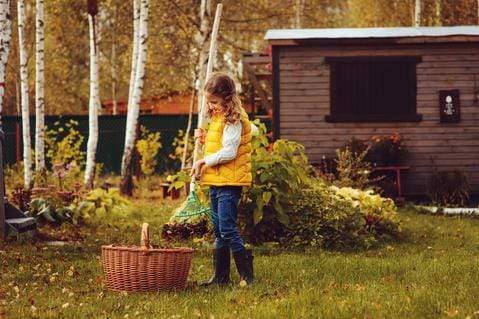Pinetree Garden Seeds Guide To Winterizing Your Garden
At the height of harvest season, winter is so hard to imagine. Gardens suddenly bursting with tomatoes, squash, eggplants, herbs, and more can keep gardeners too busy picking, cooking, and putting up preserves to notice earlier sunsets or cooler nights and mornings. But by the time pumpkins and squash start to glow, you just know—the growing season is almost done.
All around the Pinetree Garden Seeds headquarters in rural Maine, we are already seeing sparks of red and yellow here and there among the trees. Cold weather comes earlier this far north and while we still have a lot of summer weather ahead, we have started getting ready to wind down some of our beds. In other zones, you may have months before your plot goes dormant but when it does, the to-do list below will help you take care and prepare for next spring!
1. Clean Up Your Garden Beds
If you are like many of our home gardening customers, you’ve slacked off a bit on gardening tasks as the season winds down—taking less time for weeding and watering and more time for harvesting, cooking, and preserving. (We get it! We do the same thing.) But when your garden’s output slows for the season, it is time to get back to tending to weeds, composting dead plants, pulling up stakes and string, and gathering other clutter that can accumulate over time in a productive garden plot.
As your plants bolt and wither, pull them out and carry them to compost or gather them in to dry or collect seeds. (If you experienced any blight or mildew problems with a plant during the growing season do not dispose of them in your compost—those stalks or vines should be burned or thrown out to avoid spreading blight the following spring.) Gather and compost any fallen, rotting fruit or vegetables. Pull up the weeds that may have taken advantage of your harvest-season distraction and pull out any stakes, cages, or string that may have supported your peas, beans, tomatoes, and vines.
2. Clean out your compost pile.
Now is the time to scoop out the last of this season’s “black gold” and work it into your recently cleaned up but tired and spent soil. As you recharge your garden beds with compost you also clear new room in your compost bins and piles for the organic material created by your clean-up. (If your existing compost isn’t quite ready yet, you can simply start new piles.)
3. Gather leaves.
Fall foliage season in rural Maine draws tourists from all around the world and we love seeing the maples, oaks, and birch surrounding our home aflame with red and orange and yellow. Once those leaves begin to fall, though, we have to work pretty hard to stay on top of fall’s signature chore—raking and composting many, many dead leaves.

Dead leaves may have gone brown but they are pure “garden gold”—a plentiful, natural ingredient for compost and garden bed covers. Most leaves will rot down into compost in less than two years but if you want to speed up the process, shred the leaves before adding them to your compost pile.
4. Test and feed your soil.
Your gardening soil needs nourishment as much as the plant life it supports and autumn is the ideal time to sample your soil and see what it lacks. Fortifying or re-mediating your soil after a long growing season balances and strengthens it for the spring planting ahead and many common soil improvements, like lime, need time over the winter to properly break down and be absorbed.
Pinetree Garden Seeds sells affordable soil tests and you may have schools nearby that will also test your soil for a fee. Testing will tell you if your soil is acid, alkaline, or neutral, and that will tell you if you need to add fertilizers.
5. Cover any unused beds.
Remember those leaves we reminded you to pick up? A thin layer of shredded dead leaves makes a wonderful, nutritious mulch for winterized garden beds! Many of our Maine neighbors gather seaweed at low tide and spread it across their garden beds before first snow to enrich and protect their soil. Organic covers and mulches do have an insulating effect, however, so keep any layers to less than two inches—a hard freeze helps your soil by naturally killing off common garden pests and diseases and you don’t want to warm your dirt too much.
6. Preserve perennials and cover fall crops.
Depending on your microclimate, perennials that flourished in the spring and summer may not be able to overwinter in the ground without freezing or rotting and even hardy perennials may need a little bit of help. Any perennials you have planted in containers will need special consideration as well. After a couple of killing frosts, dig up and divide any delicate plants that can’t get through winter in the dirt. Container plants can be taken into root cellars, or unheated garages—or even buried in the ground or compost piles. If you have shrubbery in the path of falling ice or snow, build supports or covers to protect them.
If you read our guide to succession planting, you may be trying to squeeze in one last harvest of kale, chard, beets, and more, or you might be overwintering carrots or parsnips. Good for you! You can get these crops past even a killing frost with a DIY or purchased cold frame or row cover.
7. Plant seeds and bulbs for spring.
Think back to early spring. Did your grounds take too long to brighten up? Were there any bare spots in your lawn and garden? Did deer dig up your tulips or daffodils after they broke through? Now is the time to think ahead and plant fall bulbs. (For even more spring flower fun, check out our guide to overwintering perennial flower seeds.)
Hardneck garlic bulbs also go into the ground in the fall—check out our garlic growing guide!
8. Clean, oil, and polish tools
If you are like us, the autumn garden cleanup always yields a few surprises—and one of them is usually a garden tool you thought you had lost. Gather up all your garden tools and give them a thorough cleaning, oiling, and/or polishing before storing them someplace safe for the winter. Broken garden tools can be dangerous! Make sure you mend or replace any tools that took a beating during the season.
9. Make repairs and improvements
Rotting wood in raised beds? Trellises coming away from a wall? The slower pace of fall makes it the perfect time to cross nagging repair and maintenance tasks from your to-do list. It is also the perfect time to clear or build new beds, create cold frames, or any other changes you wished for over the summer.
10. Take notes on the previous year—and set goals for next year’s garden.
Take a moment to write down the highs and lows of this year’s growing season. What seeds did well, and which seeds disappointed you? If you plan on rotating crops, where should next year’s plantings go? Did you wish you had planted more of one thing and less of another? Are there any new tricks or techniques you would like to try? These notes can be invaluable when you begin purchasing seeds and other supplies for next year’s garden.
Whew! You did it—and you can get back to enjoying all the fun the fall season has to offer. Carve your homegrown pumpkins with your kids. Bake and cook your favorite recipes for Thanksgiving dinner using ingredients from your harvest. Dry herbs and flowers you gathered in to make holiday gifts like wreaths, natural health remedies, soaps, natural dyes, and more. Or simply sit by the woodstove and dream of next year’s garden.


I love this! Thanks for some great tips and information!
Thanks for this helpful e mail!
I needed to learn about these facts.
Thank you 😊
Moving to our new home soon, new garden to start from scratch! Looking forward to it but much work ahead, any helpful hints?
Can I cover rose bush with pine needles?